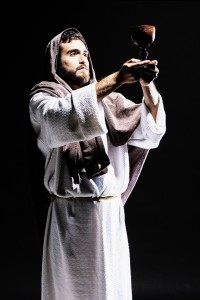John 13:8, You will never wash. Peter rejected Yeshua’s washing his feet not because of human obstinateness, but because of his honor for Yeshua. Washing the feet of one’s guests was an act of hospitality on the part of a host and was usually performed by a servant, not the host. Peter considered it to be demeaning for the Master to be performing the task of a servant, yet this is exactly what Yeshua was attempting to demonstrate. As the Messiah, he came to lay down his life in loving service for his disciples and not to be served (Matt 20:28; John 10:15; 15:13). Yeshua then made the point that his disciples should following his example in serving one another (vv. 12–17).
Tag Archives: Passover
Is There Aviv Barley in the Land of Israel Now…or Not?
This year there has been some confusion as to whether the barley in the land of Israel was really aviv (or abib) or not. Some aviv barley search groups say yes, and some say no. Why the confusion, and who is right? Eventually each person has to make up their own mind, but below we will present the reasons why we agree with those who say that the barley isn’t aviv yet.
At this point, some of you may be saying, “Huh?” when it comes to the term aviv barley. What is aviv barley and what does that have to do with anything that pertains to me? So let’s quickly review some basic truths regarding the biblical calendar. It all has to do with when to keep the biblical feasts.
The Bible stipulates that months on the biblical calendar begin when the new moon is sighted. (I’ve already written several article on this subject, so I won’t give all the Scripture references here. For that info, go to http://www.hoshanarabbah.org/teaching.html#feast.) To know the dates of the biblical feasts, one must know when the months begin. To know this, one must know when the biblical new year begins—that is, when the first day of the first month of the biblical new year is.
On our modern Roman calendar, determining new year’s day each year easy to do. But this is not the case with the biblical calendar. This is why. The Roman calendar is based on the solar cycle, which is 365 1/4 days long. By contrast, the biblical calendar is a luni-solar calendar. This means it’s based on the solar cycle AND the lunar cycle. The latter is only 354 days long, or roughly 11 days shorter than the Continue reading
New Video: From Egypt to the Mountain of YHVH — The Gospel Message
In this video, we will learn how the children of Israel’s deliverance from Egypt and trek to Mount Sinai where YHVH gave them his instructions in righteousness in preparation for entering the Promised Land contains the full gospel message. It is the story of our spiritual journey, and gives us inisghts into what lies ahead for us en route to the Promised Land of our spiritual and eternal inheritance through Yeshua the Messiah.
What is the “cup of salvation?”
Psalms 116:13, Cup of Salvation [Yeshua]. This is the only place this phrase occurs in the Scriptures, and it’s prophetic significance should not to be overlooked.
The Hebrew word cup [kos] often relates to Elohim’s judgment as he pours out his wrath upon rebellious people (e.g. Jer 25:15). Yeshua encountered this cup at Gethsemane (Matt 26:39).
There is also a cup of blessing, which men can drink from if they choose to do so. This is the cup of YHVH’s blessing and forgiveness through Yeshua that he offers to men. This is the subject of this passage. Interestingly, the third cup of the Passover seder is called the cup of redemption (or salvation). This is the communion cup that Yeshua offered his disciples at the last supper. It was this cup that represented the blood of the Savior and that was taken along with the unleavened bread representing Yeshua’s body. This same cup of salvation pictures the saint’s blessed relationship with Yeshua, and is a picture of the new covenant, which, in reality, is the saint’s entering into a state of marriage betrothal to Yeshua their heavenly Bridegroom.
Three Feasts, Three Rooms and Three Spiritual Levels
Exodus 23:14–19, Three times you shall keep a feast.
Conventional Jewish wisdom teaches us that during the three biblical pilgrimage festivals of Passover/Unleavened Bread, Pentecost and Tabernacles all the individuals of the nation are to leave their place of individual isolation and are to rendezvous in the presence of the one Elohim of Israel. This was to occur in the festival circle (or chag) around the common sanctuary (where YHVH has chosen to place his name, Deut 16:2, 11, 15), thereby becoming conscious that each one is connected to all the other members of the nation, with YHVH Elohim, and with the Torah (The Pentateuch—Deuteronomy, p. 310, by S. R. Hirsch). In biblical times, the Israelites would gather wherever the tabernacle had been placed. When the temple was built in Jerusalem, this city became the destination of the Israelite pilgrims on these three biblical feasts.

But there is much more to this spiritual picture if we add Yeshua the Messiah of Israel into the picture, for each of the three feasts point directly to him. Passover and the Feast of Unleavened Bread, the Feast of Weeks or Pentecost, and the Feast of Tabernacles all point to Yeshua, since the first two festal periods point to Yeshua’s first coming, while the last fall feast points to his second coming. Each of these feasts represent milestones in the spiritual journey of the redeemed believer from initial redemption to glorification and eternal life in the presence of YHVH Elohim.
There were three sections in the Tabernacle of Moses (Heb. mishkan): the outer courtyard, the holy place and the holy of holies. These three correspond with the three parts of man, which are his body, soul and spirit (1 Thess 5:23). The feasts of Passover (Heb. Pesach) and Unleavened Bread (Heb. Chag haMatzot) are the first two feasts the righteous believers are to celebrate in the spring and represent the first steps in a new believer’s spiritual walk. This corresponds with the outer courtyard and relates more to the spiritual cleansing of the outer parts or body of man. It is here that one begins their spiritual walk and relationship with Yeshua, who is the Word of Elohim. The Feast of Weeks or Pentecost (Heb. Shavuot) is the next step one takes in their spiritual walk as one goes inside the Tabernacle of Moses. The tabernacle’s holy place speaks of bringing the soul (the mind, will and emotions) into submission to the will of YHVH as one advances in their spiritual walk and learns about the fruits and gifts of the Spirit of Elohim, who they are as redeemed Israelites, and about worship and praise.
Finally, the holy of holies corresponds to the Feast of Tabernacles (Heb. Chag haSukkot) and the spirit part of man. This part of the tabernacle speaks more to man’s ultimate spiritual relationship with Elohim. It is here that man relates to Elohim, who is a Spirit, on a deeper spirit to Spirit level (John 4:24; 1 Cor 2:10–13). This prophetically points to man’s ultimate destiny as glorified beings in the New Jerusalem as adopted members into the family of Elohim (John 1:12; Rom 8:14–15, 23; 9:4; 2 Cor 6:18; Gal 4:5–6; Eph 1:5; 1 John 3:1; Rev 21:7).
One Law for All People for All Time!
Exodus 12: 49, One law. (Other “one law” passages include Lev 24:22; Num 9:14; 15:16, 29.) The context of this verse regards the observance of Passover (also Num 9:14). There was to be only one law pertaining to the observance of the Passover for both the native Israelite and for the stranger who sojourns with the Israelite. Leviticus 24:22 says that there is one law for the Israelite and the stranger in the areas of blasphemy, murder, slaying another man’s animal, and harming one’s neighbor in any way. Pertaining to the law about the various offerings for sin (i.e, despising the instructions or Torah of Elohim, verse 31), Numbers 15:15–16 and 29 states there is one law for both the Israelite and the sojourner forever throughout their generations.
Some will say that these “one Torah-law for everyone” passages pertain only to the specific Torah laws mentioned in these passages. In numerous places, Israel was to take the Torah (the whole Torah) to the nations of the world, not just parts of the Torah (e.g., Deut 4:6–8; Isa 60:1–3; Zech 8:22–23; Matt 28:18–20; Luke 24:47). Moreover, during the Messianic Age (or Millennium), the Torah will go forth to all the nations (Isa 2:3; Mic 4:2). What’s more, there are numerous places in the Testimony of Yeshua that speak of Torah as the standard of righteousness for all believers for all time (e.g., Matt 5:17–19; John 14:15; Rom 3:31; 7:12, 14, 22; 1 John 2:3–6; 3:4; Rev 22:14). Hundreds of more citations could be added to this list from the apostolic writings alone!
So the Torah was not for Israel only, but ultimately was to be for all the peoples of the earth. This includes you and me.
Who is the One who killed the firstborn of Egypt?
Exodus 12:23, 27 cp. 6:6 (also Deut 5:15; 7:19), The destroyer…who passed over…he smote the Egyptians cp. Will redeem you with an outstretched arm. Who is the outstretched arm or YHVH? It is Yeshua (Isa 53:1 cp. Isa 52:10; 40:10; Ezek 20:34–35) who is at the right hand of Elohim (e.g., Rom 8:34; Col 3:1; etc.). We know that the preincarnate Yeshua, the Malak (mistranslated in most Bibles as Angel) or Messenger of YHVH led Israel through the wilderness. Likely, the preincarate Yeshua was the arm of YHVH’s judgment against Egypt’s firstborn, even as he will be the hand of Elohim’s judgment against the wicked in last days and at his second coming (Rev 19:15, 21).




